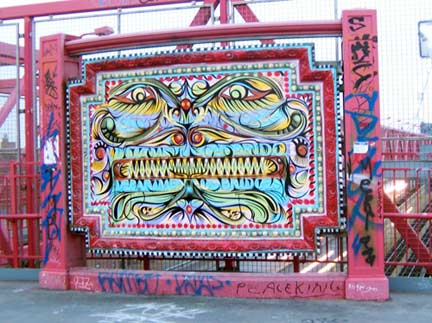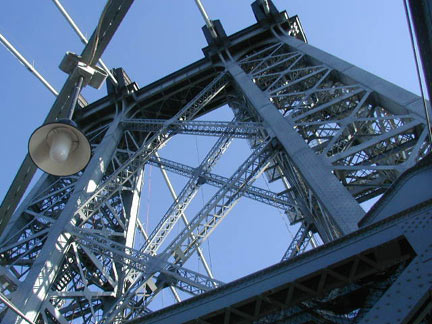It was 20 years ago (as I write in 2008) that the Williamsburg Bridge was shut down briefly as the then-85 year old bridge was discovered to have serious structural damage, corrosion in the cables and steel supports, more or less the result of deferred maintenance over the decades. A 15-year rehabilitation began in 1991 that reinforced the bridge from top to bottom and provided new roadways, pedestrian paths, and supports for the BMT tracks that support the J and M subway lines (service was suspended for several months in 1999).
In November 2003, just before the 100th anniversary of the bridge, I walked across and admired the handiwork that was just winding up. The pictures from that day have somehow avoided being used till now.
Was there a big celebration at the centennial of the Willie B.? In 1983 I recall being part of a huge throng at the Brooklyn Heights Promenade as bands played and fireworks went off to celebrate the Brooklyn Bridge’s 100th anniversary, but I don’t recall anything being done for the Williamsburg. In 2009, the Manhattan Bridge, the Queensboro (59th Street) Bridge and the Lincoln Penny celebrate their centennials. I hope something is done for all three icons.
Turns out the Willie B did have a low-key celebration.
Even though the Williamsburg Bridge was built before the Manhattan and Queensboro Bridges were, it somehow seems more utilitarian and businesslike than its two followers and that’s reflected in its entrance on Delancey and Clinton Streets on the Lower East Side. There’s nothing like the grand arch modeled on Paris’ Porte St.-Denis on theManhattan Bridge entrance on the Bowery, or even the pair of ornate lampposts (one of which remains) on the 2nd Avenue Queensboro Bridge entrance. Of course, the Queens and Brooklyn ends of our East River crossings have no such grand markers.
There is however, a nice-enough concrete portico that frames the new pedestrian walkway.
At least twice, the plaque has been visited by the Minneapolis artist known as Deuce Seven.
As a rule, though, the taggings are more or less run of the mill. Above photos by your webmaster and from Gothamist, Razor Apple, and Not Asked Back.
The “bigloop” bridge lampposts seem to be copies of the 14th Street lamps, but they’re actually a hommage to the lamps that appeared on the bridge when it was first built. ABOVE: Terrific “WB” ironwork from the original pedestrian path. These were all removed during the 1991-2005 renovation; I last saw one at a flea market on East Houston street. Amazing stuff, forever lost.
 In 1903 the city placed a lengthier plaque across the bridge roadway. When the bridge was built, the auto was in its infancy and equine traffic was still the primary means of travel, and people could actually read what was on it. By the late 20s and early 30s, pedal to the metal traffic had supplanted Old Paint and the plaque was less important, the 1991-2005 renovations seem to de-emphasize it completely.
In 1903 the city placed a lengthier plaque across the bridge roadway. When the bridge was built, the auto was in its infancy and equine traffic was still the primary means of travel, and people could actually read what was on it. By the late 20s and early 30s, pedal to the metal traffic had supplanted Old Paint and the plaque was less important, the 1991-2005 renovations seem to de-emphasize it completely.
The reconstruction of the walkway was masterful. Not only are tremendous views of the East River, Manhattan and Brooklyn available, you also pass under a tangle of girders. Cars rush on either side of you and trains rumble alongside. And, how often in NYC can you have an example of single-point perspective in which all lines converge at a point in the distance.
 Across the street, Henry Shrady’s equestrian statue of George Washington depicts him at Valley Forge: cold and weary, yet determined. Walk to the side of the plaza nearest Roebling Street and frame the statue between the two domed banks for an inspirational vista.
Across the street, Henry Shrady’s equestrian statue of George Washington depicts him at Valley Forge: cold and weary, yet determined. Walk to the side of the plaza nearest Roebling Street and frame the statue between the two domed banks for an inspirational vista.

















1 comment
I came here today looking for a photo of the “old” bridge logo used on the pedestrian path. I was not disappointed! Riding the J/M across the bridge during my visits to NYC, this was one of two things I looked forward to seeing every time on that ride (the other–the proscenium of the now-long-gone Broadway (Rio Pedras) theater ruins at 912 Broadway/Stockton that were visible from the Myrtle Av. station platforms where the M sometimes terminates.) I was disappointed to see that all of these beauties were removed during the “renovation”. At least the plaque survived.